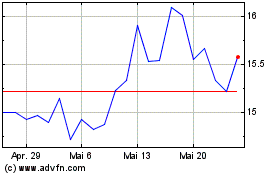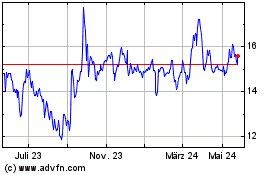Provides Business Update
Modiv Industrial, Inc. (“Modiv” or the “Company”) (NYSE:MDV),
the only public REIT exclusively focused on acquiring industrial
manufacturing real estate properties, today announced that it will
report third quarter 2024 financial results for the quarter ended
September 30, 2024 before the market opens on Wednesday, November
6, 2024. Management will host a conference call the same day at
11:00 a.m. Eastern Time to discuss the results.
Live conference call: 1-877-407-0789 or 1-201-689-8562 at
11:00 a.m. Eastern Time, Wednesday, November 6th.
Webcast: To listen to the webcast, either live or
archived, use this link
https://viavid.webcasts.com/starthere.jsp?ei=1693498&tp_key=a423007083
or visit the investor relations page of Modiv’s website at
www.modiv.com.
The following is a statement from Aaron Halfacre, CEO of Modiv
Industrial:
“A little over ten years ago I was hired as the Chief Investment
Officer of a publicly traded student housing REIT. For those who
know, you know, but suffice it to say I stepped into a FUBAR
situation due to a half-completed merger and an onerous joint
venture arrangement. The founding CEO of that company had entered
those arrangements full of optimism as he had become seemingly
addicted to the insatiable demand for growth capital. We have all
heard the story of a growth-hungry CEO who, fixated on the belief
that bigger is better, enters an overly complex and sensationally
usurious joint venture arrangement where the best-case scenario is
shareholder dilution and the worst-case results in the REIT
overdosing on a poorly structured deal. In the case of that student
housing REIT, it ultimately ended up delisting in a take private
transaction, salvaging the remaining equity value, to that same
joint venture partner. Mind you, this isn’t a missive about bad
private equity partners, or loathsome joint venture arrangements
for that matter, but it is a lesson in knowing that all things come
with a cost and that cost can be exacerbated by cognitive biases –
particularly overt optimism in lieu of thoughtful risk
management.
Joint venture arrangements take many flavors but are typically
complex both for REITs and public REIT investors – and investors
have long told REIT management they don’t really like them that
much. Typically, the JV jitters that cause public REIT investors to
develop a nervous twitch are those of the private equity ilk, as
opposed to the lower cost pension plan varieties witnessed during
the dawn of the ‘modern REIT era’. It is important to know the
dangers of anything you ingest, even if there also may be benefits.
With JVs you must be careful and smart. If you can, then you reach
new highs. If you can’t, then you may face painful investor
withdrawal. To play on the words of Rick James, ‘JVs are a hell of
a drug.’
As most of you know, for the entire year I have been yarning
about battleships as a metaphor for JVs and most recently was
focused on a particular battleship located alongside the ‘shore of
Miami’. Alas, I may never be able to fully explain the nautically
themed enigma given that we have decided not to enter our first
port of call. Before I dig into the details, I wish to personally
thank the team on the other side of the negotiations for that deal
for their patience and effort as we tried to hammer out a rare
win-win joint venture. It was a gritty journey, starting all the
way back in 2022, but at the end of the day it is my job as CEO to
make sure we don’t enter any arrangement that creates unnecessary
risk exposure. In this case, avoiding risk also means foregoing a
titillating headline. What will not be forsaken, however, is our
disciplined grind to maximize shareholder value. Before I get back
to the grindstone, please allow me to provide a bit more
context.
This particular ‘battleship’ consisted of over 20 manufacturing
properties located throughout the eastern part of the United
States. The industry mix was diverse, and all the tenants were
manufacturing durable, essential products. We had negotiated a
nine-figure purchase price at a cap rate that was accretive to
Modiv and positive to the current private equity owner. Further, we
had negotiated a joint venture arrangement whereby Modiv would have
acquired slightly less than half the equity in the portfolio on day
one for a mix of cash and common stock (as mentioned previously, at
an attractive share price). We intended to acquire the remainder of
the portfolio’s equity, and to retire its in place debt, after
recycling a small handful of non-manufacturing properties in our
existing portfolio via a ROFO that was embedded in the joint
venture agreement. Sounds good, right? Then why did we not do the
deal?
At its simplest level we had a misunderstanding relating to time
horizons. Specifically, the ROFO was long tailed, more than one
year, and the long-dated expiration was essential for us to have
enough time to properly (i.e. unrushed) sell a select list of our
existing properties and to roll the tax-sensitive proceeds, via a
1031 exchange, into the remainder of the joint venture portfolio.
We had underwritten buying the remainder of the portfolio at the
cap rate we had negotiated for the first phase of the deal – that
was a misunderstanding, and I own that. The private equity partner
was willing to honor the same cap rate if we could purchase the
remainder relatively quickly, but anything longer than a couple of
months would be a new negotiation. Rushing to sell the short list
of assets too soon increased the risk of reduced proceeds and, in
turn, would jeopardize accretion. The prospect of buying only half
and not knowing if we could even buy the remainder of the portfolio
sounds a lot like what happened at the student housing REIT all
those years ago. The job of management is to maximize value for
stockholders while also managing risk – overt optimism be
damned.
Given the run up in REIT equity prices and the Fed’s recent
surprise move, both parties knew the landscape for real estate was
shifting and instead of spending excess legal dollars in an
ill-fated attempt to paper over fundamental differences in time
horizons, we agreed to end negotiations. I believe we did so
amicably. I also believe that next to the owners themselves, there
is no one else that knows that portfolio as well as we do. Though I
would like to one day figure out a way to buy it, I am not holding
my breath, and I don’t think you should either – if it happens, it
happens.
Before you ask, our decision to pass on the deal has no bearing
on the other battleship associated with an ‘English shore’. That
opportunity isn’t dead. That said, we don’t intend to continue the
play-by-play announcements as we have in the past. If something
materializes from any potential negotiations regarding the other
portfolio, then we will let you know only if something gets
signed.
I look forward to sharing our solid results for the third
quarter on November 6th. Until then, rest assured that we are
diligently protecting your dividend and working tirelessly to
maximize your investment. For those investors reading this, know
this…you own an unapologetic portfolio of high-quality industrial
manufacturing properties where hard-working Americans make durable,
essential products of value for our nation’s infrastructure. Made
in the USA goods that can’t be found on the shelves of dollar
stores or shopping malls and won’t be left forgotten in a
self-storage unit.
Grit, grind, get it done!” Aaron Halfacre, CEO of Modiv
Industrial.
About Modiv Industrial
Modiv Industrial, Inc. is an internally managed REIT that is
focused on single-tenant net-lease industrial manufacturing real
estate. The Company actively acquires critical industrial
manufacturing properties with long-term leases to tenants that fuel
the national economy and strengthen the nation’s supply chains. For
more information, please visit: www.modiv.com.
Forward-looking Statements
Certain statements contained in this press release, other than
historical facts, may be considered forward looking statements
within the meaning of Section 27A of the Securities Act of 1933, as
amended, and Section 21E of the Securities Exchange Act of 1934, as
amended. These statements include, but are not limited to,
statements regarding our plans, strategies and prospects, both
business and financial. Such forward-looking statements are subject
to various risks and uncertainties, including but not limited to
those described under the section entitled “Risk Factors” in the
Company’s Annual Report on Form 10-K for the year ended December
31, 2023 filed with the SEC on March 7, 2024. Accordingly, there
are or will be important factors that could cause actual outcomes
or results to differ materially from those indicated in these
statements. These factors should not be construed as exhaustive and
should be read in conjunction with the other cautionary statements
that are included in this press release and in the Company’s other
filings with the SEC. Any forward-looking statements herein speak
only as of the time when made and are based on information
available to the Company as of such date and are qualified in their
entirety by this cautionary statement. The Company assumes no
obligation to revise or update any such statement now or in the
future, unless required by law.
View source
version on businesswire.com: https://www.businesswire.com/news/home/20241017764984/en/
Inquiries: management@modiv.com
Modiv Industrial (NYSE:MDV)
Historical Stock Chart
Von Dez 2024 bis Jan 2025

Modiv Industrial (NYSE:MDV)
Historical Stock Chart
Von Jan 2024 bis Jan 2025
